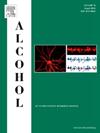酒精会加剧实验小鼠的创伤后应激精神病行为及其神经病理学后果:吗啉的预防作用。
IF 2.9
4区 医学
Q3 PHARMACOLOGY & PHARMACY
引用次数: 0
摘要
创伤后应激障碍(PTSD)和酒精使用障碍(AUD)非常普遍,并且同时存在。由于病理生理机制尚不明确,酒精如何加剧创伤后应激障碍的困境尚不清楚。此外,迄今为止,有关能有效逆转 PTSD-AUD 并发症的药理药剂的研究还很少。因此,我们设计了一种方法来研究小鼠神经保护类黄酮 Morin 的病理生理机制和药理结果。小鼠在单次长期应激(SPS)诱导后出现7天的创伤后应激障碍,在第8-21天期间,每隔一天用乙醇(2克/千克,口服)给小鼠间歇性狂饮乙醇,同时每天给小鼠服用吗啉(50和100毫克/千克)或氟西汀(10毫克/千克)。对小鼠前额皮质、纹状体和海马的创伤后应激障碍-AUD行为、下丘脑-垂体-肾上腺轴(HPA轴)功能障碍、神经化学、氧化/硝酸应激和炎症的后果进行了评估。通过减少皮质酮释放和肾上腺肥大,莫林和氟西汀可减轻小鼠因 SPS-乙醇相互作用而加剧的焦虑样行为、空间/非空间记忆缺陷、一般抑郁表型和社会应激易感性。SPS-乙醇会加剧多巴胺、5-羟色胺和谷氨酸脱羧酶的改变,以及纹状体、前足叶和海马中单胺氧化酶-B和乙酰胆碱酯酶的亢进,而吗啉可以防止这些改变。与 SPS-乙醇加重相比,吗啉能防止 TNF-α 和 IL-6 的释放、丙二醛和亚硝酸盐水平的升高,并能改善海马、前脑功能区和纹状体的抗氧化剂(谷胱甘肽、超氧化物歧化酶、过氧化氢酶)水平。总之,这些研究结果表明,AUD 加剧创伤后应激障碍的主要机制可能与 HPA 轴功能障碍加剧、神经化学降解酶上调、氧化/硝能应激和神经炎症增强有关。本文章由计算机程序翻译,如有差异,请以英文原文为准。
Alcohol exacerbates post-traumatic stress psychiatric behavior and its neuropathological sequalae in experimental mice: preventive effects of morin
Posttraumatic stress disorder (PTSD) and alcohol use disorder (AUD) are very prevalent and co-occurring. It is unclear how alcohol exacerbates PTSD predicaments owing to less characterized pathophysiological mechanisms. Also, studies on pharmacological agents that can effectively reverse PTSD-AUD comorbidity have, to date, been scarce. Hence, we designed a methodological approach to investigate the pathophysiological mechanisms and pharmacological outcomes of morin, a neuroprotective flavonoid in mice. After 7 days of PTSD following single-prolonged stress (SPS) induction in mice, the PTSD mice were exposed to intermittent binge ethanol administration using ethanol (2 g/kg, oral gavage) every other day, alongside daily morin (50 and 100 mg/kg) or fluoxetine (10 mg/kg) from days 8–21. The consequences of PTSD-AUD behavior, hypothalamic-pituitary-adrenal-axis (HPA-axis) dysfunction, neurochemistry, oxidative/nitrergic stress, and inflammation were evaluated in the prefrontal cortex (PFC), striatum, and hippocampus of mice. The exacerbated anxiety-like behavior, and spatial/non-spatial memory deficits, with general depressive phenotypes and social stress susceptibility by SPS-ethanol interaction, were alleviated by morin and fluoxetine, evidenced by reduced corticosterone release and adrenal hypertrophy. SPS-ethanol exacerbates dopamine, serotonin, and glutamic acid decarboxylase alterations, and monoamine oxidase-B and acetylcholinesterase hyperactivities in the striatum, PFC, and hippocampus, respectively, which were prevented by morin. Compared to SPS-ethanol aggravation, morin reduced TNF-α and IL-6 release, malondialdehyde and nitrite levels, with improved antioxidant (glutathione, superoxide-dismutase, catalase) levels in the hippocampus, PFC, and striatum. Overall, these findings suggest that AUD-exacerbated PTSD might be primarily connected, among other mechanisms, with aggravated HPA-axis dysfunction, upregulated neurochemical degradative enzymes, enhancement of oxidative/nitrergic stress and neuroinflammation, and stereo-selectively in the mice brains, which morin abated via the preventive mechanisms.
求助全文
通过发布文献求助,成功后即可免费获取论文全文。
去求助
来源期刊

Alcohol
医学-毒理学
CiteScore
4.60
自引率
4.30%
发文量
74
审稿时长
15.6 weeks
期刊介绍:
Alcohol is an international, peer-reviewed journal that is devoted to publishing multi-disciplinary biomedical research on all aspects of the actions or effects of alcohol on the nervous system or on other organ systems. Emphasis is given to studies into the causes and consequences of alcohol abuse and alcoholism, and biomedical aspects of diagnosis, etiology, treatment or prevention of alcohol-related health effects.
Intended for both research scientists and practicing clinicians, the journal publishes original research on the neurobiological, neurobehavioral, and pathophysiological processes associated with alcohol drinking, alcohol abuse, alcohol-seeking behavior, tolerance, dependence, withdrawal, protracted abstinence, and relapse. In addition, the journal reports studies on the effects alcohol on brain mechanisms of neuroplasticity over the life span, biological factors associated with adolescent alcohol abuse, pharmacotherapeutic strategies in the treatment of alcoholism, biological and biochemical markers of alcohol abuse and alcoholism, pathological effects of uncontrolled drinking, biomedical and molecular factors in the effects on liver, immune system, and other organ systems, and biomedical aspects of fetal alcohol spectrum disorder including mechanisms of damage, diagnosis and early detection, treatment, and prevention. Articles are published from all levels of biomedical inquiry, including the following: molecular and cellular studies of alcohol''s actions in vitro and in vivo; animal model studies of genetic, pharmacological, behavioral, developmental or pathophysiological aspects of alcohol; human studies of genetic, behavioral, cognitive, neuroimaging, or pathological aspects of alcohol drinking; clinical studies of diagnosis (including dual diagnosis), treatment, prevention, and epidemiology. The journal will publish 9 issues per year; the accepted abbreviation for Alcohol for bibliographic citation is Alcohol.
 求助内容:
求助内容: 应助结果提醒方式:
应助结果提醒方式:


